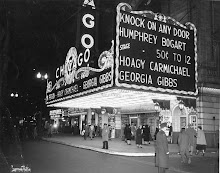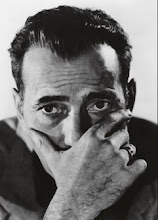First released in 1942, ACROSS THE PACIFIC is a fascinating film because it portrays a superstar in the making – not yet fully formed but about to blossom from a caterpillar into a butterfly.
With "The Maltese Falcon" the previous year, Humphrey Bogart demonstrated he had the star quality to carry a film. His rather slapdash performance here indicates that confidence had possibly gone to his head a little (or maybe more accurately to the heads of Warner Bros who controlled Bogie's career), but by the time he made "Casablanca" (immediately after PACIFIC) all the components were in place to create the legend he became.
Set in November 1941, ACROSS THE PACIFIC sees him playing disgraced US Army officer Rick Leland. Dishonorably discharged from the service, he boards a Japanese freighter bound for the Orient, hoping to start a new life.
The only other passengers are his "Maltese Falcon" co-stars Mary Astor and Sydney Greenstreet. and Dr Lorenz.
Astor is Alberta Marlow, a breathless and excitable department store worker from Medicine Hat, Canada, taking her first big vacation. Greenstreet is Dr Lorenz, a Professor of Sociology at the University of Manila. He’s also a vocal admirer of the Japanese at a time when the Empire of the Rising Sun is edging towards war with the United States.
Rick wastes little time in romancing Alberta, while also making plain to Dr Lorenz his disillusionment with America.
It gives nothing away to reveal that this is a story about espionage and romance, themes that Warner Brothers were to blend time and time again during the early1940s. ACROSS THE PACIFIC is an enjoyable, but not classic example of the genre.
Bogart’s Rick Leland lacks the depth to make him a fully rounded character. After the progress he made the previous year with "The Maltese Falcon" and "High Sierra", Leland is a disappointing throwback to the one dimensional roles he’d been typecast in since the mid 30s.
Bogart rushes from one incident to the next without ever really convincing us he’s doing more than playing a part, while his rapid romancing of Astor comes across as a horny teenager who’s inexplicably got lucky.
His womanising as Sam Spade in "The Maltese Falcon" was credible in the context of the character. Here it isn’t.
Astor played the femme fatale in Falcon, and again portrays a woman who’s clearly not as naïve as she would have everyone believe. Marlow is a class turn, trading sexual banter with Leland within minutes of their first meeting. It's these barely disguised sexual double entendres which give this story its spark. They’re genuinely witty, which makes it more surprising that she’s also so compliant at yielding to Leland’s desires.
Dr Lorenz is a variation on Greenstreet's Kasper Gutman in "Falcon", malevolent, deceptive and ruthless, but lacking the depth he brought to his screen debut.
The overall impression is of a talented cast and director (John Huston) having fun with an undistinguished script.
If Warner Brothers had stuck with their plans to cast Ronald Reagan instead of Bogart in the lead role in "Casablanca" ACROSS THE PACIFIC would have sunk without trace decades ago. Thankfully they came to their senses and PACIFIC assumed an important place in Bogart’s rise from actor to superstar. An interesting and entertaining minor thriller, the film's serves to increase our appreciation of the films Bogart made immediately before and after it.



No comments:
Post a Comment